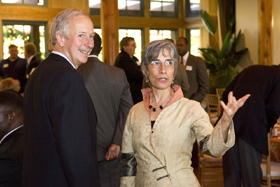Linda Belans: The Art of Diversity

Linda Belans knows the power of story.
That's one reason she created "Gathering in the Stories," -- a series of portraits of Duke employees and medical students that honors Martin Luther King, Jr. and the profound effect he had on this community.
The collection of portraits and stories create a personal connection between members of the Duke community and King. Everyone pictured holds has a memento that represents the impact of the civil rights era on their lives: a program from a Civil Rights march, a megaphone used in a segregated school. Every portrait is connected to a story about how King and the Civil Rights Movement affected the person pictured.
"It was a powerful experience to interview these employees," says Belans, the director of Health Arts Network at Duke (HAND). "Many of the participants said they had never told these stories before, particularly at Duke. They appreciated the opportunity."
Belans gained permission to have the installation permanently housed in the lower level of the Duke Clinic building so that people could see it each and every day and reflect on what King has brought to our lives and what we bring to our community. She arranged it so that the stories could continue: nestled next to the photographs is a comment book, filling up, day by day, with more and more stories.
Art and Diversity
The creation of the "Gathering in the Stories" is just one of the reasons Belans received the Duke University Diversity Award for 2006.
"Linda uses the arts and humanities to celebrate the diversity that is central to Duke University Medical Center," says Grey Brown, who nominated her. "Through HAND, Linda seeks to improve cross-cultural understanding and appreciation."
Take, for example, heart disease.
Belans used the power of the arts to draw attention to issues of racial inequality in how this country cares for people with heart disease. In April, she arranged for scenes from the play "Heart to Heart: Ain't Your Life Worth Saving" to be performed for the North Carolina Health Summit, hosted by Duke. She collaborated with North Carolina Central University and Brown University to bring the play to Duke.
"'Heart to Heart' explores health disparities and heart disease among African-American women and their families," she says. "The play drives the issues home."
It also became the cornerstone for the discussion of health disparities in North Carolina. Senior administrators were so impressed and moved that they are seeking a way to bring "Heart to Heart" to medical students as well.
Celebrating Diversity
"Diverse" is also the perfect way to describe the wide range of fine arts that Belans and her staff bring into Duke Hospital.
"One of the missions central to HAND is to honor the diversity of the medical center by reflecting its many cultures in all of its programs," says Belans.
That's why, on any given day, you might find Teresa Fernandez and Silvano Casero singing songs from Cuba and Argentina at the patient bedside; Braima Mowi telling stories from the African tradition on the Williams Unit; patients viewing an exhibit of photos from Nigeria and Senegal in the Mars Gallery in the hall leading toward the Searle Center.
The HANDs "Performers at the Bedside" program has brought the African American Dance Ensemble, Japanese performers Eiko and Koma, gospel choirs, rap poets and magicians to entertain those confined to bed, and the people who care for them.
"What I love about these programs is that they reflect so many of the different aspects that make up our lives," says Belans. "Diversity is about so much more than issues of race; it's about diversity of gender, culture, socio-economic status, age, opinions, ways of thinking, physical abilities."
And don't forget language. Belans' face lights up as she remembers the conversations around planning the "Women on Bedrest" pilot progrom. "The project was intended to offer arts and journaling to women confined to their beds due to high-risk pregnancies," she says. "From the very beginning, I wrote into the budget a line item for translators so that we could reach out to women for whom English isn't their native language," she says. "It was the right thing to do."
Bringing Out the Best
For Belans, the arts are much more than just entertainment. "They comfort and heal. They remind patients that they are more than their illness," she says; "that they are complete whole human beings whose lives are reflected in the arts and humanities we offer them. They help people make connections. And they challenge the way people think."
According to Belans, when a patient sees someone in a wheelchair dancing, they see possibilities that they might never have thought of. When a family member reads a poem in the hallway, it may open them up to a train of thought never captured before. "The arts are instruments for living that patients and their families can take with them when they leave the hospital."
In her work, Belans always keeps in mind a quote from Dr. King: "Life's most persistent and urgent question is: what are you doing for others?"
"My personal mission," she says, "is to bring out the best in others -- with a lot of laughs along the way."